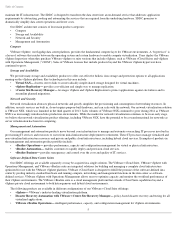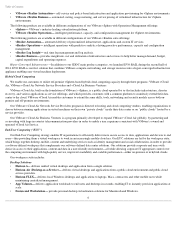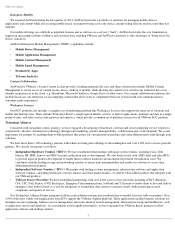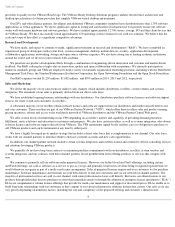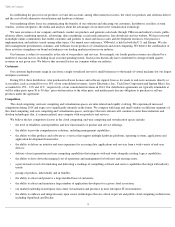VMware 2014 Annual Report Download - page 17
Download and view the complete annual report
Please find page 17 of the 2014 VMware annual report below. You can navigate through the pages in the report by either clicking on the pages listed below, or by using the keyword search tool below to find specific information within the annual report.
Table of Contents
provisioning and management of IT services across heterogeneous environments, and Nicira, a developer of software-defined networking and a
leader in network virtualization for open source initiatives. In 2013, we acquired Virsto Software, a developer of software that optimizes storage
performance and utilization in virtual environments. These acquired technologies, combined with existing technologies, constitute the basis for
our SDDC private cloud offerings.
We also continue to expand and enhance our end-user computing offerings, such as VMware View and Horizon Suite, a solution that
provides end users with a single place to get access to their applications, data and desktops and gives IT a single management console to manage
entitlements, policies and security.
In the second quarter of 2013, we introduced our hybrid cloud service called vCloud Air (formerly, vCloud Hybrid Service). vCloud Air is
designed to deliver a public cloud as a service offering that is interoperable with our customers’ existing VMware virtualized infrastructure,
enabling customers to extend the same skills, tools, networking and security models across both on-premise and off-premise environments.
In the first quarter of 2014, we acquired AirWatch, a leader in enterprise mobility management and security solutions. The acquisition of
AirWatch expands our portfolio of mobile solutions within the enterprise mobility and security space.
In the third quarter of 2014, we announced that we had entered into a joint venture with the Softbank Group to expand our vCloud Air
service to Japan. We are currently making significant investments in developing and introducing new technologies and product offerings related
to our SDDC, vCloud Air and end-user and mobile computing initiatives.
The expansion of our offerings to deliver the SDDC, address IT management and automation, add network and storage virtualization, and
enhance our end-user computing capabilities and our hybrid cloud offerings subjects us to additional risks, such as the following:
15
• These initiatives may present new and difficult technological challenges. Significant investments will be required to acquire and
develop solutions to those challenges. Customers may choose not to adopt our new product or service offerings and we may be unable
to recoup or realize a reasonable return on our investments.
• Some of our new initiatives are hosted by third parties whom we do not control but whose failure to prevent service disruptions, or
other failures or breaches may require us to issue credits or refunds or indemnify or otherwise be liable to customers or third parties for
damages that may occur. Any transition of our services from a third party hosting service to our own data centers would also entail a
risk of service disruption during a transition. We may be subject to claims if customers of these service offerings experience service
disruptions or failures, security breaches, data losses or other quality issues.
• The success of these new offerings depends upon the cooperation of hardware, software and cloud hosting vendors to ensure
interoperability with our products and offer compatible products and services to end users. If we are unable to obtain such cooperation,
it may be difficult and more costly for us to achieve functionality and service levels that would make our services attractive to end
users.
• We will need to develop and implement appropriate go-to-market strategies and train our sales force in order to effectively market
offerings in product categories in which we may have less experience than our competitors. Accordingly, end users could choose
competing products and services over ours, even if such offerings are less advanced than ours.
• Our increasing focus on developing and marketing IT management and automation and infrastructure-as-a-service (including software-
defined networking and vCloud Air) offerings that enable customers to transform their IT systems will require a greater focus on
marketing and selling product suites and more holistic solutions, rather than selling on a product-by-product basis. Consequently, we
will need to develop new strategies for marketing and selling our offerings, our customers’ purchasing decisions may become more
complex and require additional levels of approval and the duration of sales cycles for our offerings may increase.
• We will need to develop appropriate pricing strategies for our new product initiatives. For example, it has frequently been challenging
for software companies to derive significant revenue streams from open source projects, such as certain of our offerings. Additionally,
in some cases our new product initiatives are predicated on converting free and trial users to paying customers of the premium tiers of
these services, and therefore we must maintain a sufficient conversion ratio for such services to be profitable. Also, certain of our new
product initiatives have a subscription model. We may not be able to accurately predict subscription renewal rates or their impact on
results, and because revenue is recognized for our services over the term of the subscription, downturns or upturns in sales may not be
immediately reflected in our results. Moreover, as customers transition to our hybrid cloud and SaaS products and services, our revenue
growth rate may be adversely impacted, during the period of transition as we will recognize less revenue up-front than we would
otherwise recognize as part of a multi-year license arrangement.


